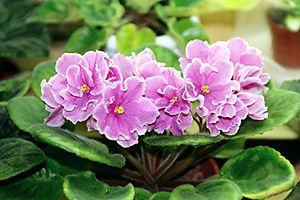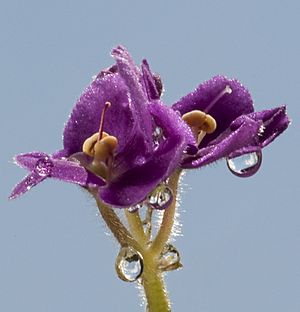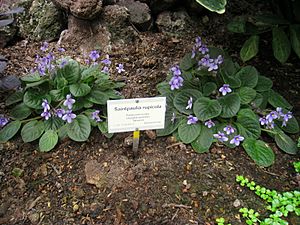African violet facts for kids
Quick facts for kids African violet |
|
|---|---|
 |
|
| A Saintpaulia ionantha cultivar | |
| Scientific classification | |
| Species | |
|
Saintpaulia goetzeana |
Saintpaulia, often called the African violet, is a group of flowering plants. These plants are known for their beautiful flowers and fuzzy leaves. They are native to Tanzania and Kenya in eastern Africa. African violets are very popular as indoor houseplants around the world.
Many types of African violets are in danger of disappearing. This is because their natural homes, called cloud forests, are being cut down. These forests are cleared to make space for farms. One type, Saintpaulia ionantha, is considered "near-threatened." This means it could become endangered soon.
Contents
What Do African Violets Look Like?
African violets usually grow to be about 6–15 centimeters (2.5–6 inches) tall. They can spread out to be 6–30 centimeters (2.5–12 inches) wide. Their leaves are round or oval-shaped. They are usually 2.5–8.5 centimeters (1–3.3 inches) long. The leaves feel a bit fleshy and are covered in fine hairs.
The flowers are about 2–3 centimeters (0.8–1.2 inches) across. They have five soft, velvety petals. These flowers grow in groups of 3 to 10 or more. Wild African violets can have flowers that are violet, purple, light blue, or white.
How Big Can African Violets Get?
African violets come in different sizes. Their size is based on how wide the plant grows. Here is a general guide for their sizes:
- Micro: Less than 3 inches (7.5 cm) wide.
- Super-mini: 3 to 4 inches (7.5–10 cm) wide.
- Mini: Between 4 and 6 inches (10–15 cm) wide.
- Semi-mini: Between 6 and 8-10 inches (15–25 cm) wide.
- Standard: Between 8-10 to 12-16 inches (20–40 cm) wide.
- Large/Giant: Over 12-16 inches (30–40 cm) wide.
How Do African Violets Grow?
Temperature Needs
African violets are very sensitive to temperature changes. If cold water spills on their leaves, it can cause dark spots. This happens because the sudden cold damages the plant's leaf cells. Always use room temperature water when watering your African violet!
How to Grow New Plants
It's easy to grow new African violets from an existing plant. You can divide a larger plant into smaller ones. You can also grow new plants from just a single leaf! This is called propagation.
Growing African violets from seed is not very common. Most plants you buy are grown from leaf cuttings or special plant growing methods.
When Do They Flower?
African violets can bloom at any time of the year. They do not need a specific amount of daylight or darkness to make flowers. This is why they are often called "day-neutral plants."
Where Do African Violets Live?
African violets naturally grow in eastern tropical Africa. Many different types of these plants are found in the Nguru mountains of Tanzania.
Growing African Violets at Home
African violets are very popular houseplants. Most of the African violets you see in stores come from one main type, Saintpaulia ionantha. However, plant breeders are now looking at other types of wild African violets. They want to use these to create new and exciting varieties with different colors and shapes.
The African Violet Society of America is a group that helps keep track of all the different types of African violets. They make sure each new plant variety has a unique name.
African Violets in Culture
African violets have a special meaning in many cultures. They are often linked to mothers and motherhood. Because of this, they are a traditional gift for mothers in many parts of the world. African violets are also sometimes given as gifts for Easter and Valentine's Day.
Images for kids
See also
 In Spanish: Violeta africana para niños
In Spanish: Violeta africana para niños






